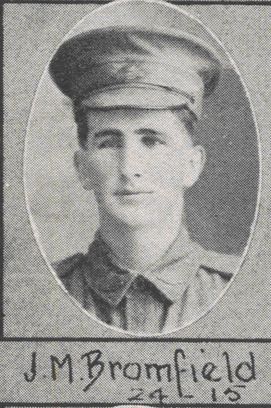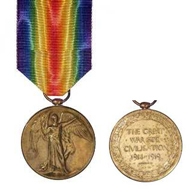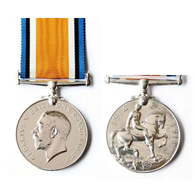BROMFIELD Jack Mawdsley
-

- 7199
- Private
- 15 Battalion
- Witta, Maleny
- Yes
- 1894
- Richmond, Northern Rivers district, NSW
- 11 November 1916
- HMAT A33 Ayrshire
- 24 January 1917
- Sydney
-
Family
John (Jack) Mawdsley Bromfield was born at Richmond in the Northern Rivers district of NSW in 1894, one of five children born to Charles Astley and Mary Josephine Agnes (nee Molan) Bromfield. Their eldest, Davenport, was born in Victoria in 1891. The second son, Astley James had been born in 1893 in the Waverley district, Sydney. The family moved to north Queensland after Jack was born. A fourth boy, Herbert Joseph, was born in 1897 but lived only twelve days. Grace Mawdsley Mary Bromfield was born on 23 March 1902.
The Electoral Rolls of 1903 and 1905 recorded the family at "Gunnawarra" cattle station, Mount Garnet, where Charles was manager. In 1908, Charles was an auctioneer. By 1913, he was a selector at Malanda on the Atherton Tableland.
On 27 September 1915, Astley ("Jim") Bromfield, a book keeper, enlisted in Townsville. He was assigned initially with 25th Battalion and embarked from Australia on 30 December 1915 aboard HMAT A50 "Itonus". He would later transfer to 7th Machine Gun Company and then the 2nd Machine Gun Battalion. His brother Jack Bromfield enlisted in November 1916. Astley would survive the war but Jack would not. Astley even re-enlisted after his first discharge and, as a member of AIF Special Services, accompanied German Prisoners of War from Australia back to Europe.
Military Context
The 15th Battalion was raised six weeks after the outbreak of the War. Three-quarters of the battalion were recruited as volunteers from Queensland, and the rest from Tasmania. With the 13th, 14th, and 16th Battalions, it formed the 4th Brigade commanded by Colonel John Monash.
The recruits trained in Victoria and embarked just before Christmas. After a brief stop in Albany, Western Australia, the battalion proceed to Egypt arriving there in early February 1915. The Australian 1st Division was already there. When the 4th Brigade arrived, it became part of the New Zealand and Australian Division. The 4th Brigade landed at Anzac Cove late in the afternoon of 25 April 1915.
After evacuation from Gallipoli and return to Egypt in December, the 15th Battalion was split and provided experienced soldiers for the 47th Battalion. The 4th Brigade was combined with the 12th and 13th Brigades to form the 4th Australian Division. In June 1916, they sailed for France and the Western Front.
Enlistment
Jack Mawdsley Bromfield enlisted at the Rifle Range, Cairns on 11 November 1916. The great conflict which would claim his life had exactly two years left to run. His age was 22 years 2 months and his occupation "farmer". He was 5 feet 10 inches in height, weighed 154 pounds, of fair complexion, with blue eyes and brown hair. His religion was Roman Catholic. He recorded his father Charles Astley Bromfield of Atherton via Cairns as his next of kin. His Service Number was 7199.
On 28th November, prior to embarkation, he was granted leave to travel to Longreach to visit his aunt and cousins.
Military Service
Private Jack Bromfield was assigned to the 24th Reinforcements of the 15th Battalion. On 24 January 1917, he embarked from Sydney on HMAT A33 "Ayrshire" bound for England. Just where a soldier might be absent without leave on the high seas is difficult to imagine, but Private Bromfield was confined to barracks/base for seven days and fined one day's pay for thirteen hours of absence. He disembarked at Devonport, Devon on 12 April 1917. Then he marched into the 4th Training Battalion at Codford on the Salisbury Plain, Wiltshire. The area hosted a major concentration of camps supporting units on the Continent. On 19 April, he found time to write a letter home to "Mart", a friend at Maleny. The fragile original of his letter, written on both sides of the page, is held at the R.S.L. archives in Maleny:
"April 19th 1917 Dear Mart, We arrived here safely 3 days ago, and not a bit sorry to get off the boat. We were 11 weeks altogether on the boat and had a good trip over. I haven't seen Jim (Researcher's note: Jack's brother Astley James Bromfield) since we landed. I believe his lot are in camp about 9 miles away from here and the way things are run over here it will be hard to get over. He gave the lot on the boat a shock when he won the heavy weight boxing Comp. The chap he was up against was half a stone heavier and supposed to be a gun, but in the second round Jim landed him 2 beauties and he skied the towel. This is a terribly cold place. The night we arrived in Devonport there was sleet and snow and there is a wind blows here that cuts like a knife. There is a big review of troops by the King 17 miles away from here and only we new fellows left in camp and we are doing Guard and fatigue work at present. I suppose when they come back we will get the drill stuck into us. In about a weeks time, we get 4 days leave will go up to London and see what it looks like up there. We have only drawn 2 pounds since we left Sydney & at present funds are terribly low, a fellow has to bum smokes wherever he can. Tucker is pretty short over here. They put us on an ......now and I hope they won't cut us any shorter or I'll starve because in this cold weather a man can eat like a horse. Well I suppose you are married by this. Jim said you were expecting to do the trick, it is a more sensible thing to do than coming over here. If I ever have the luck to get back, there will be no more for me. Well Mart, I am just about punctured so will ring off.
Remember me to all Maleny people. I remain Yours sincerely Jack Bromfield"
Luck would not smile on him.
While Private Bromfield was disembarking at Devonport, his soon-to-be comrades in arms in 15th Battalion on the continent, along with most in the brigade, were dealing with the shocking aftermath of horrendous casualties suffered in an assault at Bullecourt. There, the brigade attacked strong German positions without prior advancing artillery bombardment and without adequate tank support.
On 16 July, Private Bromfield left Codford for Southampton and proceeded to Le Havre, France (just a week earlier, his brother Davenport back in Queensland had celebrated his first wedding anniversary to Miss Emily Dorothea Johnson). As was practice in the field, soldiers were periodically given opportunity to consider their Wills. On 18th July, Private Jack Bromfield refreshed his, leaving all his personal estate to his mother living in Roseville. Very sadly, Private Bromfield would be killed two weeks before his Will reached its first anniversary.
He joined the 15th Battalion in the field on 4 August. When the 24th Reinforcements including Jack Bromfield arrived on the continent, the focus was in Belgium and an advance on the Hindenburg Line.
On 21 September, Private Bromfield reported sick and he was transported by Field Ambulance to No.1 Casualty Clearing Station at Chocques but then moved on to the 3rd Stationary Hospital at Rouen. He was suffering pyrexia of unknown origin (P.U.O.). There would have been no wounds visible as cause of infection, no obvious viral explanation, but still the soldier would have had a persistent raging temperature. By 26 September, he was sufficiently improved to transfer to No.2 Convalescent Depot, Two days later, he was fully recovered and marched out to the 4th Australian Divisional Base Depot at Le Havre. He rejoined his unit in the field on 6 October. His total absence from the line had been 15 days.
In October 1917, Charles Bromfield from Atherton wrote to Base Records. He requested that, in future, cabled reports regarding their sons be sent directly to their mother who was in Sydney. Because cables rarely conveyed good news, he must have prayed no further cables would come, but his hopes were forlorn.
On 21st December, Private Bromfield was ill again and took one week to recover.
In March and April 1918, the 15th Battalion helped stop the German spring offensive. On 28 March, Private Bromfield suffered gunshot wounds to his face and left knee. He was transported by Field Ambulance to 56th Casualty Clearing Station at Gezaincourt but next day transferred to 20th General Hospital, Camiers. His mother, who was living at Malanda, Pockley Avenue, Roseville, North Sydney, was advised of his wounding on 15 April. On 29 May 1918, he rejoined his unit in the field.
On 4 July 1918, in the first hours of the Battle of Hamel, Private Jack Bromfield was killed by a trench mortar shell. He was buried later that day at the place where he died, about 1400 yards south west of Hamel. The burial was performed by the 15th Battalion Pioneers under Corporal McQuillan. A simple wooden cross marked the grave. Quite comprehensive detail of Jack's death and burial were communicated to Base Records from London in January 1919 but rather less was eventually communicated to the family at Chatswood on 3 March 1919.
Jack's personal effects crossed the oceans on the "Austral Glen". On 22 March 1919, they were delivered to the family at Chatswood. They comprised: letters, photos, cards and Prayer book - a meagre return, but precious items to grieving parents at home.
After the War
In January 1919, Astley Bromfield sought and was granted leave to travel to France. He was issued a special passport for the purpose of trying to locate his brother's remains in the field grave. For a soldier on his own, and without the significant resources that would later be applied through the Graves Unit to recover and then re-inter at Crucifix Corner, his effort went unrewarded.
Jack's father received photos of the grave site in March 1920. In due course followed the British War Medal on 27 May 1921, the Memorial Scroll and King's Message on 23 June 1922 and the Victory Medal on 2 June 1923. They were symbols of a grateful King and Country but scant solace for a young life lost.
Jack Bromfield made the supreme sacrifice but his brother Astley was also wounded on two occasions. A steady stream of adverse news in telegrams from France beginning in February 1916 must have caused Charles and Mary Bromfield to wonder if they would ever see either of their boys again.
Jack's remains were exhumed after Armistice and re-interred in Crucifix Corner of the War Cemetery at Villers-Bretonneux. The grave site is Plot IX, Row B, Grave 7.
With one brother lost but one returned, Grace Bromfield married Edward John McGuinness, medical practitioner, on 15 August 1923. Astley Bromfield returned from war to North Queensland. On 5 February 1934, he married Doringcourt Marie Long.
Charles Bromfield died on 1 April 1937 and Mary Josephine Bromfield on 14 June 1940. Both were buried at Lutwyche cemetery. Their eldest son, Davenport, died on 12th December 1939.
Grace died on 22 July 1964. A year earlier, the Electoral Roll had recorded Edward and her living in Henry Street, Ascot with their son Edward Francis McGuinness, also a medical practioner.
In the Electoral Rolls from 1949 to 1980, Astley was a hotelkeeper, and he and his wife lived in Hughenden and Townsville. In the roll of 1963, their daughter Mary Gail was recorded with them. Astley Bromfield died on 25 August 1985.
-
- Hamel
- Somme
- Western Front
-

-

- Killed in action
- 4 July 1918
- Hamel
- 24 years
- Grave IX B 7, Crucifix Corner, Villers-Bretonneux war cemetery, France
-
Witta and District Roll of Honor Maleny R.S.L. Memorial Hall, Bunya Street, Maleny
A "Poppy Cross" of remembrance on behalf of the family and "Adopt a Digger" was placed on Jack's grave at Crucifix Corner by Kerrie and Grant Thorne on 19 July 2014.
-
Australian War Memorial
National Australian Archive
Trove digitalized newspapers
History of the 15th Battalion AIF 1914-1918 by Lieutenant T.P. Chataway
Photographs of Crucifix Corner (Villers-Bretonneux) on 19 July 2014 supplied by Kerrie and Grant Thorne
Jack's letter home on 19 April 1917 kindly located in RSL Archives and typed by Desley Malone of Maleny
The information provided by Gail Mosch, niece of Jack Bromfield, is gratefully acknowledged.
- Grant Thorne





